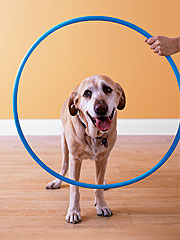 By Allison Arthur, GPG Blogger/Volunteer
By Allison Arthur, GPG Blogger/Volunteer
We’ve all been there – watching Westminster or maybe just the neighbor’s dog – wondering how their pets learned so many tricks when our own hasn’t mastered nearly as many. Then we sigh and think, “Oh well. Old dogs can’t learn new tricks,” and forget about it.
Well, we’re all wrong, because old dogs can learn new tricks. If your dog is past those puppy “prime-training” years, never fear, he or she can still learn new things.
Here’s how to do it:
1. Start Fresh 
First, you need to break old habits. This is the most important step for older dogs, who, most likely, have gotten away with quite a bit in their lifetime. (Don’t worry – I’m guilty of this myself! I’m speaking from experience.) Have an alpha dog problem in your household? Make sure your pup knows who’s boss. He or she won’t listen to you, let alone learn, from you, if you don’t assume authority. That means disciplining your dog when he or she breaks the rules. I won’t get into how to do that now – that’s for another post, but here are a few good articles from the dog expert: Cesar Milan on Discipline
One thing to never do is to hit your dog. That doesn’t teach your dog anything but to fear you. Respect can be earned without inducing fear. This is especially important for a rescued dog, who may have been abused at one point in his or her life.
2. Introduction the Trick
Start by going over the trick with your dog by physically helping him or her while saying the command. I taught Ruby how to put her paw in my hand by saying, “Paw” while picking up her foot. She learned how to sit by me pushing her butt down while saying, “Sit.”
3. Reward Success
Once your dog can do the trick by your command only, it’s time to reinforce with a treat. Go with something small – most pet stores sell “training treats,” which can be given often without making a dog sick.
This is also a point in the training in which you have to interpret what’s best for your dog. If he or she isn’t doing the trick without your help, you may need to introduce treats earlier. Sometimes, when Ruby is right on the edge of learning
something but won’t do it on the command only, I’ll give her a treat. For example, she started learning to give me her paw when I would move my hand to reach for her foot but not on command only. That’s when I started giving her treats. Within a
few tries, she gave me her paw on command without me needing to reach for it. You know your dog best, and this is when your intuition will serve you best in training.
4. Repeat, Repeat, Repeat
A trick isn’t learned in one sitting. It’s rarely learned in one day. Even worse, it’s easily forgotten. Practice with your dog for at least ten minutes every day, and definitely don’t go for long periods of time without practicing. Dogs, like humans, forget things too!
Remember, dogs don’t lose intelligence as they age. The trick to learning anything is repetition. Just keep with it, and don’t let your furry friend fall into bad habits!
Still need some proof? Mythbusters taught two seven-year old Alaskan malamutes, of a notoriously stubborn breed, new tricks in four days.
What are some tricks you’ve taught your older dog? We’d love to hear about them!
[spacer height=”15px”][divider][spacer height=”15px”]
[alert type=”warning” color=”#888″ show_close=”true”]Back to Gateway Pet Gazette Front Page. Click here for more stories.[/alert]
[divider]

